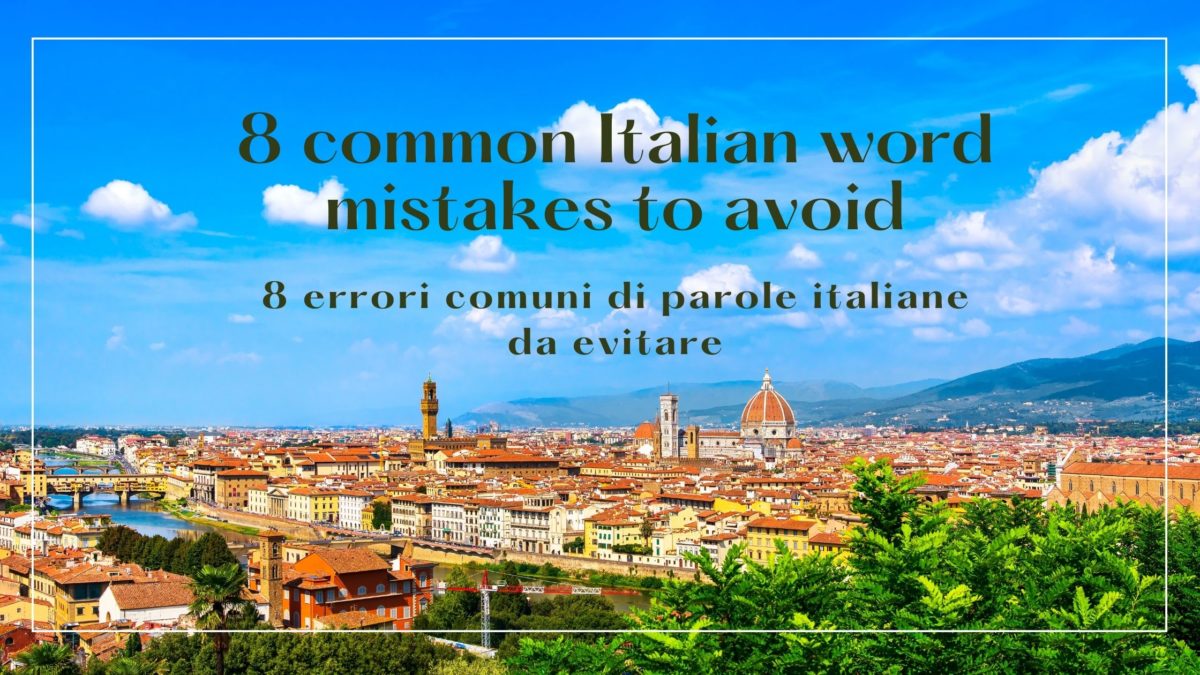Negli ultimi due decenni molte parole italiane sono state assorbite nelle abitudini di vita di tutto il mondo. Sebbene a volte il significato di queste parole, spesso relative al cibo, ad alcuni sia sconosciuto, sono tuttavia pronunciate con orgoglio. Vorrei che i laboriosi immigrati italiani della metà del XX secolo potessero vedere che l’italiano ora è di moda. Tuttavia, avrai sentito le discussioni che si stanno verificando in Italia negli ultimi anni sul fatto che la lingua italiana ha adottato molte parole straniere in particolare dall’inglese e dal francese. Al centro di queste discussioni c’è L’Accademia della Crusca, fondata nel 1583 a Firenze, i cui fondatori erano originariamente chiamati la brigata dei Crusconi e costituivano un circolo composto da poeti, letterati e giuristi. Questa società di studiosi di linguistica e filologia italiana è il più importante istituto di ricerca sulla lingua italiana, nonché la più antica accademia linguistica del mondo.
In the past couple of decades many Italian words have been absorbed in the lifestyle habits around the world. Although at times the meaning of these words, often pertaining to food, are unknown to some, they are yet uttered with pride. I wish the hard working Italian immigrants of the mid 20th century could see that Italian is now trendy. However, you may have heard the discussions taking place in Italy in recent years over the fact that the Italian language has been adopting many foreign words in particular from English and French. At the forefront of these discussions is L’Accademia della Crusca, founded in 1583 in Florence, whose founders were originally called la brigata dei Crusconi and constituted a circle composed of poets, men of letters, and lawyers. This society of scholars of Italian linguistics and philology is the most important research institution of the Italian language, as well as the oldest linguistic academy in the world.
Il suo obiettivo è di mantenere la purezza della lingua italiana. Infatti il nome Crusca è una metafora per il suo lavoro nel setacciare parole e strutture corrotte (come la crusca è separata dal grano). “Il più bel fior ne coglie”, un famoso verso del poeta italiano Francesco Petrarca è il motto dell’Accademia. Arrivati al 21° secolo c’è la preoccupazione che la lingua italiana svanisca o semplicemente diventi un minestrone. Quindi come ambasciatrice della lingua e della cultura italiana non uso mai parole straniere per sostituire una parola che già esiste in italiano. Quindi non mi sentirai mai dire “hai delle news” invece di “hai delle notizie“ oppure “nel weekend vado al mare” invece di “nel fine settimana vado al mare”.
Its goal is to maintain the purity of the Italian language. In fact Crusca, which means “bran” in Italian, is a metaphor for its work is to sift out corrupt words and structures (as bran is separated from wheat). “Il più bel fior ne coglie” (‘She gathers the fairest flower’), a famous line by the Italian poet Francesco Petrarca is the academy motto. Fast forward to the 21st century and there is concern that the Italian language will vanish or simply become un minestrone. So as an ambassador of the Italian language and culture I never use foreign words to replace a word that already exists in Italian. Therefore, you’ll never hear me say “hai delle news” instead of “hai delle notizie“ oppure “nel weekend vado al mare” instead of “nel fine settimana vado al mare“.
Se hai viaggiato in Italia, avrai notato che gli italiani apprezzano quando gli stranieri si sforzano di parlare in italiano, e non gli dispiace affatto quando pronunci male una parola o fai fatica con alcune parole o frasi, in realtà gli italiani saranno più che felici di aiutarti a dirlo nel modo giusto. Tuttavia, potresti avere problemi a farti capire se usi o pronunci parole in modo errato. Facciamo un po’ di ordine partendo dalle seguenti otto parole che ho notato in Nord America hanno particolarmente bisogno di un po’ di amore!
If you have traveled to Italy, you may have noticed that Italians appreciate it when foreigners make an effort to speak Italian, and they don’t mind it at all when you mispronounce a word or struggle with some words or phrases, actually Italians will be more than happy to help you say it just right. However, you may have problems being understood if you’re using or pronouncing words incorrectly. Let’s make some order starting from following eight words which I noticed in North America are particularly in need of a bit of love!
1. Il biscotto / i biscotti
I biscotti riportano alla memoria i ricordi d’infanzia di quando mia mamma sfornava magicamente infiniti vassoi di biscotti in appena un paio d’ore. La casa si riempiva del dolce profumo di mandorle, vaniglia, cacao, scorza di limone. Mi sembrava di vivere ”in una casa di zucchero”. Preparava abbondanti quantità di biscotti e li conservava nel congelatore per gli ospiti fortunati. Il gigante congelatore era pieno di mostaccioli, amaretti, pesche e anche tante varietà di torte. Oggigiorno i biscotti hanno conquistato il mondo al plurale, giustamente. Ma se ne ordini solo 1, e non so come fai, è un sostantivo maschile singolare ”un biscotto”, mentre il plurale è “biscotti”. Mi sembra comunque tenero sentire qualcuno ordinare i “biscottis”.
Biscotti bring back childhood memories of when my mom would magically “sfornare” /bake endless trays of biscotti in just a couple of hours. The house would be filled with the sweet smell of almonds, vanilla, cacao, lemon zest. I felt like I was living “in una casa di zucchero”. She used to make copious amounts of biscotti and treasure them in the freezer for lucky guests. The giant freezer was packed with mostaccioli, amaretti, pesche, and a variety of cakes, too. Nowadays, biscotti, not biscottis, have taken over the world in their plural form, rightfully so. But if you order just 1, and I don’t know how you do it, it’s a singular masculine noun “un biscotto”, while the plural is “biscotti”. I still think it’s endearing when I hear someone order “a biscottis.”
2. Il gelato
Tutti amano il gelato e molti vogliono provarlo anche se non sanno cosa sia. Come la signora che ho visto una volta precipitarsi in un Caffè/bar a Little Italy in College Street a Toronto chiedendo al barista se poteva avere un “gelaro” apparendo perplessa non sapendo in cosa si stesse cacciando – sicuramente qualcosa di appetitoso secondo i racconti che l’avevano portata lì in primo luogo. Il barista sorrise indicando l’affare misterioso proprio di fronte a lei e disse “…è gelato!” Il gelato più amato al mondo. In italiano la “t” non si pronuncia come una “r”. Assicurati di pronunciare la “t” con la lingua premuta contro la parte posteriore dei denti anteriori in modo da poter essere serviti senza indugio questa prelibatezza italiana congelata!
Everybody loves gelato and many want to try it even if they don’t know what it is. Like the lady who once rushed into a Cafe’ in Little Italy on College Street in Toronto asking the barista if she could have a “gelaro” appearing puzzled and not knowing what she was getting herself into – surely something yummy according to the recounts that led her there in the first place. The barista grinned indicating right in front of her and said “..it’s ice-cream!” The most loved ice-cream in the world, il gelato. The t is not pronounced as an r in Italian. Be sure to voice the t with your tongue against the back of your front teeth so you can be served this frozen Italian delicacy without delay!
3. Il latte
Latte significa latte in italiano, quindi se ordini un “latte” in Italia, ti verrà servito un bicchiere di latte. Se chiedi un “grande” (stile Starbucks), riceverai un grande bicchiere di latte semplicemente! Ma se ci vuoi davvero del caffè dentro, dovrai chiedere un caffè latte, che significa caffè con latte. Inoltre, il mio consiglio, ogni volta che ordini qualsiasi tipo di cibo in Italia di cui non sei sicuro/a, scegli quello “piccolo” per evitare grandi sorprese!
Latte means milk, so if you order a “latte” in Italy, you’ll be served a glass of milk, un bicchiere di latte. If you ask for a “grande” (Starbucks style), you’ll get a big glass of plain milk! But if you actually want some coffee in it, you really want to ask for un caffè latte, which means milk coffee. My advice is that whenever you’re ordering any kind of food in Italy that you’re unsure of, just go for piccolo “small” to avoid big surprises!
4. Il peperone
Questo è stato in realtà l’ostacolo più grande per me all’estero perché non mangio carne. In italiano il peperone è l’ortaggio. Quindi in Italia se chiedi il peperone è esattamente quello che otterrai, sicuramente non le fette di salame. Mentre invece il pepperoni, con la doppia p, è una varietà americana di salame. In italiano si chiama semplicemente salame e basta chiedere quello.
Allora, pizza con salame o pizza con peperoni?
This was actually the biggest hurdle for me abroad as I don’t eat meat. In Italian il peperone is the vegetable, the bell pepper. So in Italy if you ask for peperone then that’s exactly what you’ll get, definitely not salami slices. While on the other hand pepperoni, with a double p, is an American variety of salami. In Italian it’s simply called salame and just ask for that.
So, pizza con salame or pizza con peperoni?
5. La bruschetta
Che buona la bruschetta! Il problema è che se la pronunci nello stile inglese “brushera” i camerieri italiani in Italia saranno nel pallone! Ovviamente le tre lettere sch sono spesso pronunciate male. Ma se le pronunci bene potrai ordinare la bruschetta anche in Italia. Tecnicamente pronuncia la -s (togli il suono “sh” inglese) e pronuncia “ch” che in italiano è come la “c” di cat o la “k” di kite, e otterrete “brusketta”. E infine la doppia “t”… rendila forte, con la lingua contro i denti anteriori, e dimostra con forza che ci tieni davvero!
Che buona la bruschetta! The problem is that if you pronounce it English style “brushera” Italian waiters in Italy will be clueless! Of course thethree letters sch are often mispronounced. But if you pronounce it right you’ll be able to order la bruschetta in Italy, too. Technically you pronounce the -s (remove the “sh” sound) and pronounce “ch” which in Italian is like the “c” in cat or the “k” in kite, and you’ll get “brusketta”. And finally the double “t”… make it strong, tongue against your front teeth, and show that you really mean it!
6. Pronto vs presto
La parola “pronto” ha un altro cugino italiano che molti ignorano, ed è presto. Oggigiorno ”pronto” è usato per significare essere preparato, disposto, mentre presto significa fra breve o rapidamente! “Sono pronto/a.” Anche quando rispondi al telefono “Pronto, chi parla?” Presto è un altro paio di maniche, per esempio “Arrivo presto.”
Quindi, Sei pronto/a per andare in Italia presto?
The word “pronto” has another Italian cousin that many ignore, and that’s presto. Nowadays ”pronto” is used to mean ready and presto means soon! “Sono pronto/a” – I’m ready! Also when you answer the phone “Pronto, chi parla?” Presto has another pair of sleeves, for example “Arrivo presto.” – I’ll be there soon!
So, Sei pronto/a per andare in Italia presto?
7. Il problema
Penso che le pubblicità americane abbiano propagato l’errore ”No problemo!”. Si dice “nessun problema”. Le regole grammaticali impongono che i nomi maschili debbano terminare in -o e i nomi femminili in -a. Tuttavia, sono sicura che ormai saprai che in italiano ci sono eccezioni alla maggior parte delle regole ed eccone una. Sebbene la maggior parte dei nomi che terminano in -a siano femminili, ci sono alcuni nomi di origine greca che terminano con il suffisso -ma, che sono ancora maschili nonostante l’ingannevole desinenza -a ed è richiesto l’articolo maschile “il”. Quindi se lo desideri dai pure la colpa di questa eccezione al greco!
I think American commercials have propagated the ”No problemo!” mistake. The proper translation of “nessun problema” is “il problema”. Grammar rules dictate that masculine nouns must end in -o and feminine nouns must end in -a. However, I’m sure you know by now that in Italian there are exceptions to most rules and this is one of them. Although most nouns ending in -a are feminine, there are some nouns of Greek origin ending with the suffixe -ma, which are still masculine despite the deceiving -a ending and the masculine article “il” is required. So go ahead and blame this one on the Greek if wish!
8. Il cannolo / i cannoli
Ahimè, il cannolo proprio come il biscotto rientra nella categoria degli errori col doppio plurale. Il plurale in italiano differisce dalle altre lingue, in quanto non usa la -s, e invece si modifica la vocale che termina la parola: la -o maschile diventa -i e la -a femminile diventa -e. È comprensibile questo errore dato che i cannoli sono così buoni che vorresti moltiplicarli all’infinito chiamandoli cannolis al plurale, ma la grammatica ha i suoi limiti, per fortuna!
Alas, cannolo just like biscotto falls into the double plural mistake category. Pluralizing in italian differs from other languages, as it doesn’t use an -s, instead you modify the vowel at the end: masculine -o becomes -i and femminine -a becomes -e. This mistake is understandable since cannoli are so good you’d like to multiply them infinitely calling them cannolis in the plural form, but grammar has it’s limits, luckily!
Potrebbero esserci altre parole da aggiungere a questa lista, fammi sapere nei commenti se ne hai sentite altre che vengono spesso sbagliate!
There may be more words to add to this list, let me know in the comments if you’ve heard of any other words that are often mistaken!
A presto!
Mirella
- Il Discorso diretto e discorso indiretto in italiano

- I massacri delle foibe – Il Giorno del Ricordo

- Un racconto di Natale: Il Tesoro dei Poveri di Gabriele D’Annunzio

- Estate di San Martino- leggenda e tradizioni

- I verbi fraseologici: venire/andare a prendere

- Michela Murgia: tenace scrittrice e attivista italiana


